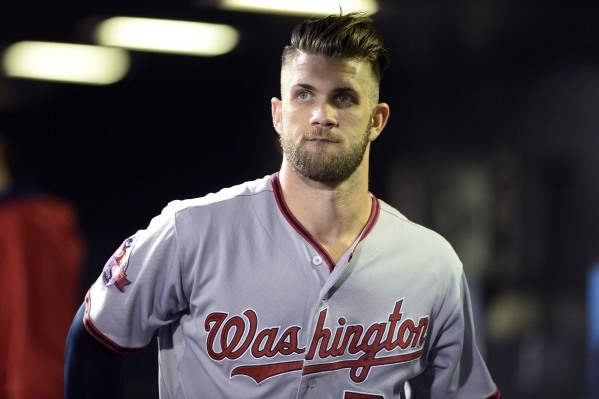MLB’s Manfred still hopes to attract youth of America



Say this for Rob Manfred: The guy stays on task.
It was a year ago when the newly elected commissioner of Major League Baseball sat at a table at the Little League World Series in Williamsport, Pa., and spoke about his top priorities in taking over for that lampshade-on-the-head charmer, Bud Selig.
“We think it’s crucial to commit resources, energy and time to the development of the game, particularly in the inner cities,” Manfred said that evening. “We think of our youth participation programs as umbrella programs — male, female, black, white, rich, poor — we want kids from all socioeconomic backgrounds playing our game.
“Programs like Little League baseball are at the top of our list for making the game inclusive for everyone. We need kids to be taken to games by their parents and grandparents, those who can help teach them the game. That is crucial.”
Manfred this week penned a guest column for ESPN.com and said his primary focus since assuming the head chair at MLB’s dinner table was to indeed improve ways the game might reach young minds.
He wants to inspire them, compel them to follow baseball, have them fall in love with the game at a time fewer kids are choosing sports as their leading after-school or weekend activity.
Is he fighting a losing battle?
Does he have a chance at changing the minds of kids who have already abandoned baseball?
Can he convince those who haven’t not to follow suit?
It begins today, an annual Little League World Series spectacle that ESPN will again televise as part of a $76 million rights fee contract, 11 days of bright lights shining upon 12-year-olds and causing us to wonder if they are prepared to handle the incredible amount of attention and admiration cast in their direction.
And then it will end, and most kids who watched the best Little Leaguers from the United States and across the globe will go back to tossing a football or shooting a basketball or kicking a soccer ball or attending a mixed martial arts class or, most likely, playing video games.
In 2013, the National Sporting Goods Association tells you, 9 million kids from the ages of 7 to 17 played baseball in the United States.
Two years later, that number was 4.3 million.
Over the same period, those playing youth softball dropped from 5.3 million to 3.2.
You can understand Manfred’s concern.
It’s not as if the reasons for such a dip in interest and participation have changed as numbers dwindle. Specialization in other sports played on a year-round basis have for some time now taken a large chunk of would-be baseball and softball players. Many kids still believe both sports are too slow, too methodical, too boring. Many in poor communities can’t afford to play them or don’t have the needed transportation to do so.
But none of it has stopped Manfred from forging ahead, from his 30 clubs jointly committing $30 million to youth baseball development.
The money helps.
This might help more: Manfred’s greatest strength in drawing young minds to the game might be, ironically, the young stars who now dominate headlines across the major leagues.
If this summer’s All-Star Game told us anything, it’s that baseball is at its most exhilarating and compelling state in years when it comes to those names garnering attention.
They’re just fun to watch, is all.
Mike Trout. Bryce Harper. Kris Bryant. Salvador Perez. Anthony Rizzo. Joc Pederson. Jose Altuve.
All are great talents.
All are 25 or younger.
Such players represented 26.3 percent of rosters for the All-Star Game, in which 32 players competed for the first time.
More than anything else, Manfred and his league need to discover how best to use the excitement generated by those young players and in turn make a connection with the millions of kids deciding whether baseball is something they want to pursue past the coach-pitch stage.
“Our research has shown that playing the game as a kid is the biggest determinant toward becoming a lifelong fan,” Manfred wrote. “The second factor is the age at which a child attends his or her first game. The younger the age, the stronger the connection becomes. We will be thoughtful in our efforts to get kids to the ballpark early and often. Keeping our game affordable and accessible is a significant part of that.”
I applaud his efforts. He’s not conceding an ounce to another sport or any Xbox waging war between plants and zombies. He continues to introduce new programs, build new fields, support and encourage and promote a new youth-participation platform.
How much any of it will stall those rapidly dropping numbers is anyone’s guess. Maybe it’s too late. Maybe it’s more about stopping the decline than actually growing the interest level.
But the commissioner has a chance. The window isn’t completely shut.
Trout and Harper and Bryant and others can indirectly cause it to open wide.
If Manfred makes them his No. 1 connection to those youth being chased, Super Smash Bros. and Mario Kart might suddenly have more competition from local sandlots.
Ed Graney can be reached at egraney@reviewjournal.com or 702-383-4618. He can be a heard on “Seat and Ed” on Fox Sports 1340 from 2 p.m. to 4 p.m. Monday through Friday. Follow him on Twitter: @edgraney.












